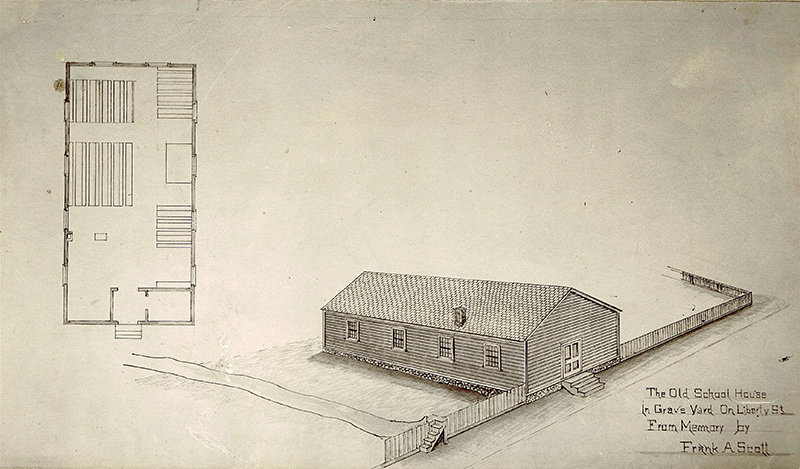
The Old Town Schoolhouse within the cemetery, facing Liberty St.
Mary McTamaney
Plans were announced by SUNY Orange this month to begin conversion of some classic old downtown buildings into educational use. Along Grand Street, the former Masonic Temple and YMCA buildings were acquired by the county with an eye to improving its campus and its program. The SUNY Orange administration discussed the potential for new vocational curriculum to prepare local community college students for jobs trending now in the 21st century.
Vocational education has a long and successful tradition in Newburgh. The oldest standing school building in Newburgh is located at 87 Clinton Street and was built in 1849 on a plot of land in the original village center, called the Glebe (thus the school was often referred to as the Glebe School).
It was not Newburgh’s first school building, but it is now the oldest. In its day, the deep brick building easily accommodated an elementary school serving downtown children. Within a half-century, Newburgh’s population had greatly increased and several more elementary schools were built on Grand Street, Washington Street, South Street and West Street. The Clinton Street School was converted into The Manual Training School, a vocational center. Desks were carried out and taken (by wagon in those days) to other schools and workbenches were constructed to stand in their places.
All around the city, boys in what today we call the “middle school” grades were dismissed early to walk to Clinton Street if their teachers and principals determined they were best suited to the trades rather than higher education. Inside the old Glebe School, they learned to cut, plane and join wood and cut and shape metal. This prepared them to enter local apprentice programs and move more quickly into a paying career.
Girls in 1900 were not part of this scheme even though nearly as many girls needed to enter the workforce as boys. There was no manual training school for them. Instead some classes in sewing were held inside elementary schools at the end of the academic day for the many young women who entered the clothing factories. More often, girls who were not headed for higher education just went straight to work. Census data is full of households with working children at the turn of the last century.
When Newburgh adopted the junior high school model in the 1930’s and built North and South Junior High Schools they incorporated vocational education into the regular curriculum. The junior highs had both wood and metal shops and they had sewing and cooking rooms too but it would take more than a generation before those programs became co-ed and before vocational education expanded its definitions to many other fields.
The opening of the junior highs marked the closing of the Manual Training School. The Glebe School transitioned to being called The Glebe House when the Girl Scouts of America moved in and made it their headquarters. I marched down Gidney Avenue for scout meetings there in the 1950’s. The Glebe House also housed the Historical Society in upstairs rooms before that organization bought the Crawford House on Montgomery Street in 1953.
Perhaps because the ancient land law term of “glebe” has long been attached to 87 Clinton Street, stories persist that it is the site of the community’s first school but this is not true. The first school was a block north, not on Clinton Street but on Liberty, probably along the east border of present Mt. St. Mary grounds. Like the original Weigand’s Tavern (also up at Broad Street near Liberty), the school built by the Palatines was a simple log structure. Later, the original site of the Palatine Lutheran Church, which was located inside what is now Old Town Cemetery, was converted to a school and used through the 1840’s until the brick one on Clinton Street opened.
A former student of the Old Glebe School, Mr. Frank A. Scott, drew a picture from memory of this wooden schoolhouse, including an interior layout. His picture is on file in the historical society archives. It shows the one-room schoolhouse we all envision with a teacher’s platform facing a set of benches and desk/counters occupied by the children. There are four sets of these desk spaces, perhaps for four grade levels plus an entry vestibule and a coatroom. Along the wooden fence that enclosed Old Town Cemetery in the early 19th century, Mr. Scott also depicts a stile (a set of steps on either side of the fence) to enter and exit the cemetery without using a gate that potentially could be left open to the farm animals, which then roamed freely through Newburgh. That would be a trick the children in that Old Town School might have enjoyed – bringing in pigs and chickens to call out under their schoolroom windows.